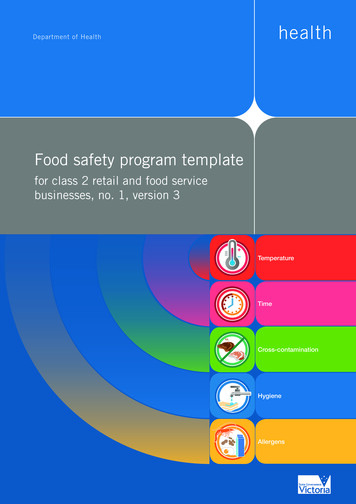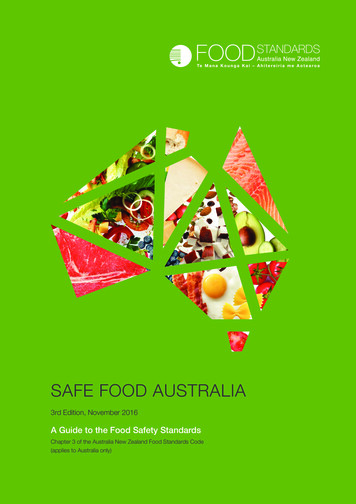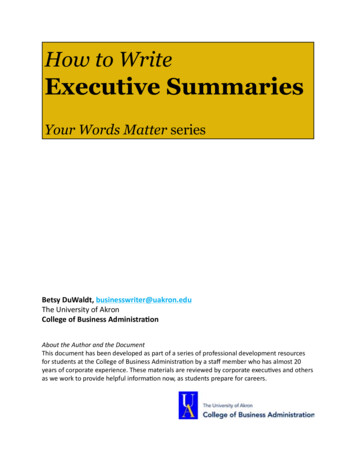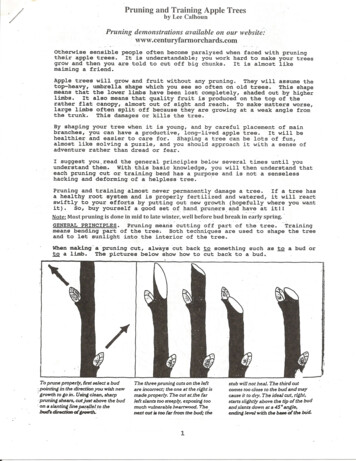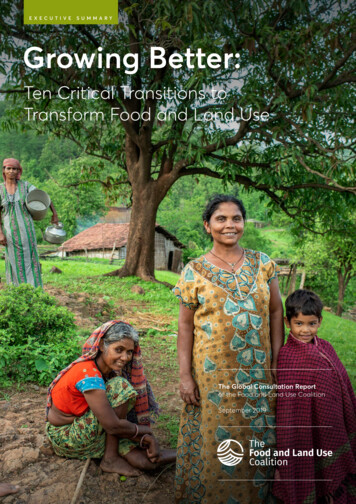
Transcription
E X EC U T I V ES U M M A RYGrowing Better:Ten Critical Transitions toTransform Food and Land UseThe Global Consultation Reportof the Food and Land Use CoalitionSeptember 2019
Table of ContentsForeword4Acknowledgements6Executive summary9Annex A:FOLU partners, supporters andAmbassadors23FOLU country platforms26References31FOLU Core PartnersSupported by2Growing Better: Ten Critical Transitions to Transform Food and Land Use
Growing Better:Ten Critical Transitions toTransform Food and Land UseThe Global Consultation Reportof the Food and Land Use CoalitionSeptember 2019Cover image:Villagers of the Sagai forest villages in the Narmada district of Gujarat, India,where land rights have been reinstated to the community members, enablingthem to make a better living by restoring and protecting the land and foreststhey depend on.
ForewordTransforming the world’s food and land use systemsis necessary to achieve the targets for climate andsustainable development set out in the 2015 SustainableDevelopment Goals and the Paris Agreement onclimate change. The Food and Land Use Coalition(FOLU) was launched in 2017 to catalyse and speed upthis transformation.FOLU’s work divides between (i) making the strategiccase for rapid change, (ii) supporting countries withtheir food and land use planning, policy and marketredesign, (iii) empowering diverse change leaders acrosspublic, private and civil society sectors, (iv) developingevidence-based transformation pathways and (v)accelerating shifts throughout the private sector.The term “food and land use systems” covers everyfactor in the ways land is used and food is produced,stored, packed, processed, traded, distributed, marketed,consumed and disposed of. It embraces the social,political, economic and environmental systems thatinfluence and are influenced by those activities. Foodfrom aquatic systems, marine and freshwater, is alsoincluded in the definition because fish (wild and farmed)accounts for a significant share of the protein in humandiets and this share will potentially increase.i The reportalso covers agriculture for non-food purposes, such asbioenergy, fibres for textiles and plantation forestryproducts, as these already compete with food for fertileland and the competition could intensify in the future.iiFOLU values independent, science-based thoughtleadership and policy recommendations and engagesdiverse stakeholders in their development. We believebusiness has a critical role to play in achieving theoutcomes for climate, biodiversity, public health andprosperous livelihoods that the world needs. The WorldBusiness Council for Sustainable Development, a FOLUcore partner, convenes business leaders to supportthem in this role. FOLU acknowledges the invaluablecontribution of Unilever, Yara International and theBusiness and Sustainable Development Commissionin nurturing our initial development.For more information, please visit our website atwww.foodandlandusecoalition.orgTo achieve its purpose, FOLU develops knowledge,tools and partnership platforms to help those involvedin economic and political decision-making to identifyand pursue pathways to sustainable food and land usesystems. We demonstrate that applying systems thinkingto these tasks can foster productive, prosperous ruraleconomies, protect and value natural resources andecosystems, and provide nutritious, affordable foodto a growing global population.iFOLU recognises the importance of the ocean as an essential source of protein and many other critical ecosystem services. We address the role of the oceanin the critical transition 4 on “Securing a healthy and productive ocean” and will look to strengthen our work on this critical aspect of the overall food and landuse agenda over the coming years.iiSee Box 25 in critical transtion 3 on Protecting and Restoring Nature in Chapter 3 of the full online report.4Growing Better: Ten Critical Transitions to Transform Food and Land Use
The final report and its content are the soleresponsibility of the Food and Land UseCoalition as represented by the undersigned:The FOLU community continues to grow and evolve.It currently comprises the following elements:Per Pharo,FOLU Global Report Editor & Co-Lead AuthorJeremy Oppenheim,FOLU Principal, Global Report Co-Lead AuthorCore Partners: organisations responsible for theCoalition’s global-level initiatives and engagement.Melissa Pinfield,FOLU Programme DirectorThese include:Caterina Ruggeri Laderchi,FOLU Global Report Research Director & Co-Author Alliance for a Green Revolution in Africa (AGRA)EATGlobal Alliance for Improved Nutrition (GAIN)International Institute for Applied Systems Analysis(IIASA)Sustainable Development Solutions Network (SDSN)SYSTEMIQWorld Business Council for Sustainable Development(WBCSD)World Resources Institute (WRI)FOLU Country Platforms: stakeholder networks thatsupport the development and implementation of foodand land use transformation strategies at the nationallevel, including through the FABLE Consortium whichcurrently comprises independent research teams from 18countries, including the European Union (see Box 39 inChapter 3 of the full online report).iiiAmbassadors: professionals who serve in an individualcapacity, drawing on their expertise to support FOLU’sobjectives.Scarlett Benson,FOLU Global Report Project Manager & Co-AuthorPaul Polman,Co-Chair of the AmbassadorsAgnes Kalibata,Co-Chair of the AmbassadorsShenggen Fan,Co-Chair of the AmbassadorsClaudia Martinez,Co-Chair of the Country ProgramsNirarta Samadhi,Co-Chair of the Country ProgramsCPG Institution Leads: Lawrence Haddad (GAIN), Peter Bakker(WBCSD), Agnes Kalibata (AGRA), Michael Obersteiner (IIASA),Andrew Steer (WRI), Jeremy Oppenheim (SYSTEMIQ),Guido Schmidt-Traub (SDSN) and Gunhild Stordalen (EAT).FOLU Country Institution Leads: Sofia Ahmed (WRI Africa, FOLUEthiopia), Eli Court (Land Use Futures Project, FOLU Australia),Xiaotian Fu (WRI China, FOLU China), Vijay Kumar (TERI, FOLU India),Claudia Martinez (E3 Asesorias, FOLU Colombia), Sonny Mumbunan(WRI Indonesia, FOLU Indonesia), Sue Pritchard (RSA, FOLU UK) andAmanda Wood (Stockholm Resilience Centre, FOLU Nordics).Supporters: donors and philanthropic organisationsproviding financial support to our work.These include: The Gordon and Betty Moore FoundationThe MAVA FoundationNorway’s International Climate and Forest Initiative(NICFI)The UK Department for International Development(DFID)These independent research teams do not necessarily reflect the viewsof their respective governments.iiiGrowing Better: Ten Critical Transitions to Transform Food and Land Use5
AcknowledgementsThis publication is funded by the Gordon and Betty Moore Foundation, the MAVA Foundation and NICFI.The field of food and land use systems is full of institutions and talented individuals doing exceptional work. We havegratefully drawn upon all of them and wish to acknowledge our debt in that regard. There is also a rich and extensivebody of existing research and analysis. The bibliography in the full online report details the key reports and analysesconsulted by this report’s authors.We would in particular like to acknowledge our debts to the following institutions outside of the Coalition:Food and agriculture:Chinese Academy of Agricultural SciencesCornell UniversityCranfield UniversityBrazilian Agricultural Research Corporation (EMBRAPA)Global Alliance for the Future of FoodInternational Federation of Organic AgricultureMovements (IFOAM)International Food Policy Research Institute (IFPRI)Alliance for a Green Revolution in AfricaConsultative Group on International AgriculturalResearch (CGIAR) centresFood and Agriculture Organization of the United Nations(FAO)Sustainable Food TrustUniversity of California, DavisUniversity of LeuvenWageningen UniversityWorld Farmers OrganisationWorld Vegetable CenterHoffmann Centre For Sustainable Resource Economyat Chatham HouseStanford UniversityThe Economics of Ecosystems and Biodiversity (TEEB)The Nature ConservancyThe United Nations Environment Programme (UNEP)The Intergovernmental Panel on Climate Change (IPCC)In particular, we would like to thank the authors of ClimateChange and Land: An IPCC Special Report on ClimateChange, Desertification, Land Degradation, Sustainable LandManagement, Food Security and Greenhouse Gas Fluxes,published August 2019The Intergovernmental Science-Policy Platform onBiodiversity and Ecosystem Services (IPBES)The International Resource PanelWorldFishWorld Wildlife Fund (WWF)Environment:The CGIAR Research Program on Agriculture forNutrition and HealthThe Institute for Health Metrics and Evaluation(University of Washington and the Global Burden ofDisease)Johns Hopkins UniversityThe Leverhulme Centre for Integrative Researchon Agriculture and Health (LCIRAH)Partners in Public HealthTufts UniversityThe World Health Organization (WHO)UNICEFBioversity InternationalCGIAR Research Program on Water, Land andEcosystemsColumbia UniversityConservation InternationalEnvironmental Market Solutions Lab (emLab) at theUniversity of California, Santa BarbaraGlobal Environment Facility (GEF)Alexander von Humboldt Biological ResourcesResearch Institute6Health:Growing Better: Ten Critical Transitions to Transform Food and Land Use
Left: Ma Jinzhong joined the farm in 2013 and is now overseeing the greenhouses at the Pear Garden Farm in Beijing, China. He reflects on how farmingapproaches are going back to traditional ways: “We used cow manure before, and we use it now. I am going back to how I worked in the beginning.”Right: Balaynesh Kasa with three of her children. She farms hops at a watershed restoration and homestead development in Bahir Dar, the Amhara Regionof Ethiopia. This provides her with enough income to support her family and send her four children to school.FOLU would like to thank the large number of individuals and institutions that have generously contributed timeand energy to comment on various drafts of this report. They include:Peter Alexander(University of Edinburgh),Fitrian Ardiansyah(IDH-The Sustainable Trade Initiative),Tim Benton(University of Leeds),Joao Campari(Food Practice Leader, WWFInternational),Arne Cartridge(Yara International),Emma Chow(Ellen MacArthur Foundation’s Foodinitiative),Nicolas Denis(McKinsey & Company),Philip Duffy(Woods Hole Research Center),John Ehrmann(Meridian Institute),Nadia El Hage Scialabba(UN FAO),Volkert Engelsman(Eosta),Madhur Gautam(Agriculture Global Practice at theWorld Bank),Daniela Goehler(Deutsche Gesellschaft fürInternationale Zusammenarbeit, onbehalf of the German Federal Ministryfor the Environment),Norbert Gorissen(German Federal Ministry for theEnvironment),Claire Kneller(WRAP Global),Joost Oorthuizen(IDH-The Sustainable Trade Initiative),Janez Potočnik(International Resource Panel),Tim Lang(City, University of London),Michael Lesnic(Meridian Institute),Martin Lok(Natural Capital Coalition),Steven Lord(University of Oxford),Will Martin(IFPRI and the InternationalAssociation of AgriculturalEconomists),Robin Maynard(Population Matters),Marco Meloni(Ellen MacArthur Foundation),Growing Better: Ten Critical Transitions to Transform Food and Land UseSabine Miltner(Conservation and Markets, Gordonand Betty Moore Foundation),Melissa Miners(Unilever),David Nabarro(4SD),Walt Reid(Conservation and Science, the Davidand Lucile Packard Foundation),Ruth Richardson(Global Alliance for the Future ofFood),Marta Santamaria(Natural Capital Coalition),Jeff Seabright(formerly Unilever; IMAGINE),Bernhard Mauritz Stormyr(Yara International),Pavan Sukhdev(President, WWF International),Pablo Vieira(NDC Partnership Support Unit),Christina Voigt(University of Oslo),Robin Willoughby(OXFAM),Simon Zadek(UNEP),Dan Zarin(Climate and Land Use Alliances).7
FOLU would also like to thank the authors and peer reviewers of the new research and analysis which has beencommissioned for this report, including: 8Charles Victor Barber and Karen Winfield, Forestand Fisheries Crime – Understanding and Overcoming aKey Barrier to Achieving Sustainable Food and Land UseGoals, WRI/FOLU Working Paper, due 2019Chris Costello, Christopher Free, Jason Maier,Tracey Mangin and Andrew Plantinga, Estimating theOcean’s True Potential for Feeding the Planet, emLab,University of California, Santa Barbara, 2019Diletta Giuliani and Katherine Stodulka, BetterFinance, Better Food: Investing in the New Food andLand Use Economy, SYSTEMIQ (Blended FinanceTaskforce), 2019Douglas Flynn, Sanna O’Connor and Morten Rossé,Prosperous Forests in the Tropical Belt, SYSTEMIQ, 2019Christophe Bellmann, Jonathan Hepburn andBernice Lee, Impacts, Barriers and Opportunities:Where Can International Trade Hinder or Help Delivera Sustainable Food and Land Use System?, HoffmannCentre for Sustainable Resource Economy atChatham House, 2019Juliano Assunção, Markets, Policies, and Technology:Pathways for Zero Deforestation Agriculture, PontificalCatholic University of Rio de Janeiro, 2019Rohini Chaturvedi, Helen Ding, Craig Hanson andFrances Seymour, Public Sector Measures to Conserveand Restore Forests: Overcoming Barriers, WRI, 2019Abdullah Mamun, Will Martin and Simla Tokgoz,Reforming Agricultural Subsidies for ImprovedEnvironmental Outcomes, IFPRI, 2019Paul Burgess, Lynda Deeks, Anil Graves and JimHarris, Regenerative Agriculture: Identifying the Impact,Enabling the Potential, Cranfield University, 2019Chris Costello, Seafood Demand Literature Review:Consumer Preferences, Drivers of Seafood Demand, andDemand for Sustainable Ocean Management, emLab,University of California, Santa Barbara, 2019Assan Ng’ombe and Julia Turner, People, Health andNature: A Sub-Saharan African Transformation Agenda,SYSTEMIQ and AGRA, 2019Christophe Bellmann, Isadora Ferreira, JonathanHepburn and Bernice Lee, The Global Food ValueChain: A Snapshot, Hoffmann Centre for SustainableResource Economy at Chatham House, 2019Brian Walsh and Julie Rozenberg, The PovertyImpacts of the FOLU Transformation, 2019Alex Blei, Urban Expansion and Cropland Impacts,Marron Institute of Urban Management, New YorkUniversity, 2019 Andre Deppermann, Hugo Valin, Mykola Gusti,Miroslav Batka, Jinfeng Chang, Christian Folberth,Stefan Frank, Petr Havlík, Nikolay Khabarov,Pekka Lauri, David Leclère, Amanda Palazzo,Frank Sperling, Marcus Thomson, and MichaelObersteiner, IIASA-FOLU Integrated Scenarios GlobalBiosphere Management Model Project, IIASA, 2019The FOLU Global Report team is grateful for the insightsand case studies relevant to corporate stakeholdersprovided by the WBCSD. The report’s recommendationsare grounded in detailed modelling work conducted bythe team at IIASA. Their work was augmented by theGlobal Burden of Disease research lab at the Universityof Washington and by an independent analyst usingthe World Bank Shockwaves model. We are grateful toall those involved. In addition, IIASA received technicalsupport from the modelling teams at ProjectingResponses of Ecological Diversity In Changing TerrestrialSystems (PREDICTS) at the London Natural HistoryMuseum and the United Nations Environment WorldConservation Monitoring Centre (UNEP-WCMC), aswell as teams at the PBL Netherlands EnvironmentalAssessment Agency using the Integrated Model to Assessthe Global Environment (IMAGE). We would also like tothank Ashkan Afshin (University of Washington), andJulie Rozenberg and Brian Walsh (The World Bank).For details of the modelling please see the ExecutiveSummary, Chapters 1 and 4, as well as the technicalannex (Annex B) in the full online report.We particularly want to thank the core team atSYSTEMIQ that has delivered the bulk of the work for thisreport: Maximilian Bucher, Gina Campbell, Annabel Farr,Natasha Ferrari, Douglas Flynn, Diletta Giuliani, ElinorNewman-Beckett, Sanna O’Connor, Alexandra Philips,Lloyd Pinnell, Rupert Simons, Talia Smith, KatherineStodulka, Julia Turner and George Wiggin.A number of people from FOLU Core Partner institutionsand the FOLU Ambassador network made importantcontributions. Our special thanks go to Andreas Merklfor his support at a crucial junction as well as: AlisonCairns (WBCSD), Ed Davey (WRI), Fabrice DeClerck(EAT), Jessica Fanzo (Johns Hopkins Berman Instituteof Bioethics), Lawrence Haddad (GAIN), Craig Hanson(WRI), Sharada Keats (GAIN), Michael Obersteiner (IIASA),Guido Schmidt-Traub (SDSN), Tim Searchinger (WRI), AnnTutwiler (Meridian Institute) and Richard Waite (WRI).Growing Better: Ten Critical Transitions to Transform Food and Land Use
Executive summary“You may delay, but time will not.”Benjamin FranklinThe world faces a remarkable opportunity to transform food and land use systems over the next ten years. Thisreport lays out the scientific evidence and economic case that demonstrate that, by 2030, food and land use systemscan help bring climate change under control, safeguard biological diversity, ensure healthier diets for all, drasticallyimprove food security and create more inclusive rural economies. And they can do that while reaping a societalreturn that is more than 15 times the related investment cost (estimated at less than 0.5 percent of global GDP) andcreating new business opportunities worth up to 4.5 trillion a year by 2030.1 Delivering such a transformation will bechallenging but will ensure that food and land use systems play their part in delivering the Sustainable DevelopmentGoals (SDGs) and the Paris Agreement targets on climate change.Leaving these systems to continue on current trends, by contrast, means sleepwalking into a scenario whereinclimate change, sea-level rise and extreme-weather events increasingly threaten human life, biodiversity andnatural resources are depleted, people increasingly suffer life-threatening, diet-induced diseases, food security iscompromised, and socioeconomic development is seriously impaired. Such a pathway would place the SDGs and theParis Agreement targets out of reach and within a few decades threaten our collective security.Transformation of food and land use systems thus needs to become an urgent priority globally – for leaders in thepublic and private sectors, and for civil society, multilateral institutions, the research community, consumers andcitizens.To support such leadership, this report from the Food and Land Use Coalition (FOLU) proposes a reform agenda.This agenda is centred around ten critical transitions that would enable food and land use systems to provide foodsecurity and healthy diets for a global population of over nine billion by 2050, while also tackling our core climate,biodiversity, health and poverty challenges (Exhibit 1). The specifics of the reform programme will inevitably vary fromone country to the next, and from one community to the next. But all countries and communities could benefit fromtaking a holistic approach to the transformation of food and land use systems, combining the massive opportunitiesthat are becoming available in respect of “nutritious food”, “nature-based solutions”, ”wider choice and supply” and“opportunity for all” agendas.Conceiving of the programme as a pyramid, the transition at the apex is toward diets that are conducive to goodhuman and planetary health. This is because the consumption patterns of more than nine billion people – what theychoose to eat and how they make (or are influenced to make) those choices – are the critical factors shaping howfood and land use systems evolve. Empowering consumers to make better-informed decisions that are healthier forthem and for the planet ignites the whole reform agenda.At the second level, the power of nature-based solutions is mobilised to create more productive, regenerativetechniques of food production, new approaches to protecting forests and other critical ecosystems, and new ways tomanage the ocean in order to protect ocean life and increase ocean protein production. All nature-based solutionshave common features. They require effective legal mechanisms to protect natural capital. They require producers– farmers, fishermen and indigenous communities – to be paid transparently and fairly for the ecosystem servicesthey provide. And they show that it is possible simultaneously to strengthen food security, tackle climate change andprotect biodiversity. No trade-off is necessary.Growing Better: Ten Critical Transitions to Transform Food and Land Use9
EXHIBIT 1Growing Better: Ten Critical Transitions to Transform Food and Land UseEconomic PrizeInvestment RequirementsBusiness Opportunity 5.7 trillion economic prize by2030 and 10.5 by 2050 basedon avoided hidden costs 300- 350 billion requiredeach year for thetransformation of food andland use systems to 2030 4.5 trillion annualopportunity for businessesassociated with the ten criticaltransitions by 2030Cross Cutting Reforms to Transform Food and Land UseGovernment: Establishtargets; break downgovernmental silos; put a priceon carbon; land use planning;repurpose agricultural supportand public procurement;massively increase R&D andtarget it on healthy, naturalsolutions.10Business & Farmers: Organisepre-competitively to supportgovernment reform agendasand set internal standards forspecific sectors; establish truecost accounting for food andland use.Investors & FinancialInstitutions: Build on the TaskForce on Climate-relatedFinancial Disclosures to covernature; develop a set offinancing principles for foodand land use; developinnovative financeinstruments, including blendedfinance, to manage risks andleverage opportunities.Participants in multilateralprocesses andmulti-stakeholderpartnerships: Raise ambition inthe United Nations FrameworkConvention on ClimateChange 2020 stock-take andensure an ambitious outcomein the 2020 Convention onBiological Diversity inKunming, China.Civil Society: Driveinformation campaigns forfood and land use reform anddirect campaigns againstserial offenders (public andprivate).Growing Better: Ten Critical Transitions to Transform Food and Land Use
FINANCIALS KEYEconomic prize by 2030Ten Critical TransitionsHealthy DietsProductive &Regenerative AgricultureEssential ActionsGlobal diets need to converge towards local variationsof the “human and planetary health diet” – apredominantly plant-based diet which includes moreprotective foods (fruits, vegetables and whole grains), adiverse protein supply, and reduced consumption ofsugar, salt and highly processed foods. As a result,consumers will enjoy a broader range of high-quality,nutritious and affordable foods.Government: Establish and promote planetary and humanhealth dietary standards through repurposed agriculturalsubsidies, targeted public food procurement, taxes andregulations on unhealthy foodAgricultural systems that are both productive andregenerative will combine traditional techniques, suchas crop rotation, controlled livestock grazing systemsand agroforestry, with advanced precision farmingtechnologies which support more judicious use of inputsincluding land, water and synthetic and bio-basedfertilisers and pesticides.Government & Business: Scale up payments for ecosystemservices (soil carbon/health and agrobiodiversity) plus improveextension services (training and access to technology, seeds, etc.)Nature must be protected and restored. This requires anend to the conversion of forests and other naturalecosystems and massive investment in restoration atscale; approximately 300 million hectares of tropicalforests need to be put into restoration by 2030.Government: Put in place and enforce a moratorium on theconversion of natural ecosystems, and give legal rights andrecognition to the territories of indigenous peoplesProtecting &Restoring NatureA Healthy &Productive OceanDiversifyingProtein SupplyReducing Food Loss& WasteLocal Loops & LinkagesHarnessing theDigital RevolutionBusiness: Redesign product portfolios based on the humanand planetary health dietBusiness & Investors: Shift procurement from buyingcommodities to investing in sustainable supply chains; deployinnovative finance to reach currently underfinanced parts ofsupply chainsGovernment: Scale REDD to 50 billion per year by 2030 ifresults delivered and establish a Global Alliance AgainstEnvironmental CrimeBusiness opportunity by 2030Financials (by 2030) 1.28 trillion 30 billion 2 trillion 1.17 trillion 35-40 billion 530 billion 895 billion 45-65 billion 200 billionBusiness: Establish transparent and deforestation-freesupply chains and demand the same of suppliersSustainable fishing and aquaculture can deliverincreased supply of ocean proteins, reducing demandfor land and supporting healthier, and more diversediets. This is only possible if essential habitats estuaries, wetlands, mangrove forests and coral reefs –are protected and restored and if nutrient and plasticpollution are curbed.Government: Protect breeding grounds, end both illegalfishing and overfishing, and provide title/ access rights toartisanal fishersRapid development of diversified sources of proteinwould complement the global transition to healthydiets. Diversification of human protein supply falls intofour main categories: aquatic, plant-based,insect-based and laboratory-cultured. These last threesources alone could account for up to 10 percent of theglobal protein market by 2030 and are expected toscale rapidly.Government: Use public procurement to secure long-termofftake for alternative protein sources 240 billionGovernment: Increase R&D spending in alternative proteins(especially those with large benefits for lower-incomeconsumers) and ensure that the resulting intellectualproperty remains in the public domain 15-25 billionApproximately one third of food produced is lost orwasted. To produce this food that is never eaten bypeople requires an agricultural area almost the size ofthe United States. Reducing food loss and waste by just25 percent would therefore lead to significant benefitsrelating to environmental, health, inclusion and foodsecurity.Government: Regulate and incentivise companies to reporton and reduce food loss and waste 455 billionInvestors: Finance income-sensitive, climate-smart storagetechnologies 30 billionWith 80 percent of food projected to be consumed incities by 2050, what urban dwellers choose to eat andhow their needs are supplied will largely shape foodand land use systems. This transition sets out theopportunity to strengthen and scale efficient andsustainable local food economies in towns and cities.Investors: Invest in emerging technologies andinnovations which will close the food system loopDigitisation of food and land use systems is occurringthrough gene-editing techniques, precision farming, andlogistics and digital marketing tools, enabling producersand consumers to make better, more informed choices,and to connect to the value chain rapidly andefficiently.Government: Open access to public sector data (e.g. onnational land registries, fisheries, agriculture, soil health etc.)and regulate and incentivise the private sector to provideopen source data where appropriateUnderlying all ten critical transitions is a vision of ruralareas transformed into places of hope and opportunity,where thriving communities can adapt to newchallenges, protect and regenerate natural capital andinvest in a better future. Ensuring a just transition.All: Establish public-private-philanthropic partnerships totrain a new generation of young farmer entrepreneurs overthe next decadeStronger RuralLivelihoodsGender & DemographyAnnual additional investment requirements to 2030Government & Investors: Develop new approaches andbusiness models for insurance against catastrophic eventsaffecting fisheries (storms, warming events, reef collapse)and for compensating poor fishermen for the cost of fishstock recovery 350 billion 10 billion 345 billion 240 billion 255 billionGovernment: City governments to foster local circularfood economy through targeted public procurementand zoningCivil Society: Create, maintain and communicate resultsfrom real-time platforms for transparency, as is currentlydone through Global Forest WatchAll: Scale up rural roads and digital investments to driveproductivity, end rural isolation, and, in particular, initiate aglobal campaign for renewable electricity access for all 240 billion 10 billion 215 billion 540 billion 15 billion 240 billion 300 billion 95-110 billion 440 billionGovernment: Safety nets for individuals and strandedcommunities to ensure a just transitionWomen can be enormously powerful in shaping foodand land use systems, thanks to their central role inagriculture and in decisions concerning nutrition, healthand family planning. Making sure women have equalaccess to resources, such as land, labour, water, creditand other services, should be central to policiesconcerning the ten critical transitions, including byaccelerating the demographic transition to areplacement rate of fertility in all countries.All: Invest in maternal and child health and nutrition as wellas education for women and girls 195 billionAll: Ensure access to reproductive health services andproducts 15 billionGrowing Better: Ten Critical Transitions to Transform Food and Land Usen/a11
The third level of the pyramid is made up of transitions that expand consumer choice and supply, especially ofresource-intensive, healthy foods such as proteins. Accelerating the diversification of protein supplies, reducing foodloss and waste, and creating more local supply chains, together with tighter resource looping, are all ways to diversifysupply, reduce environmental pressures and expand consumer access to affordable, healthy food. All need differentforms of public-private partnership and behaviour change, often at a local level, if they are to lend themselves to beingscaled up fast.Finally, the pyramid’s foundation puts opportunity for all at the heart of the transformation. The transitions at this levelwill ensure that digitisation empowers people rather than concentrates data, that investment is made in the talent,infrastructure
EXECUTIVE SUMMARY The Global Consultation Report of the Food and Land Use Coalition September 2019. Table of Contents Foreword Acknowledgements Executive summary . Cornell University Cranfield University Brazilian Agricultural Research Corporation (EMBRAPA) Global Alliance for the Future of Food




